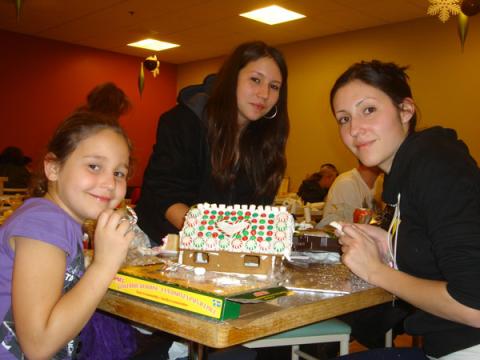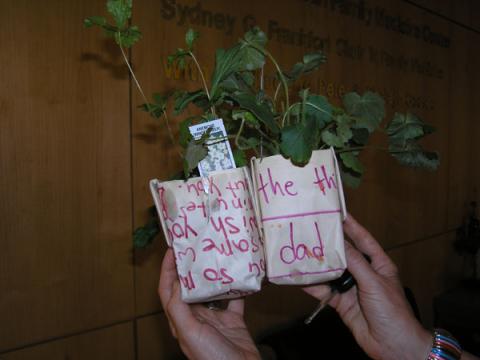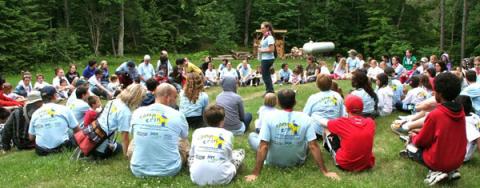
Just as Andrea Warnick. The RN and children’s grief counselor at Dr. Jay Children's Grief Program at Toronto’s Mt. Sinai Hospital is a hero to hundreds of Greater Toronto Area (GTA) families who would otherwise be struggling to explain why Mommy isn’t ever coming home or helping a terminally ill boy or girl grasp the larger context of what’s happening to them.
Established six years ago and completely donor-supported, the Dr. Jay Children's Grief Program — which, rather verbosely, operates under the Temmy Latner Centre for Palliative Care through the Max and Beatrice Wolfe Children's Centre at Mt. Sinai — has counseled hundreds of families at pretty much the worst point in their lives.
As the Program’s website notes, “Parents and caregivers… are not sure what to say and want only to protect the children and young people in their lives. This protection, however, often leads to children not fully understanding what is happening and not being included in the dying process, death rituals and family grieving.
“This can complicate the already difficult feelings of grief they are experiencing. There are healthy ways to grieve. We can help.”
And help they do, in almost alarming numbers. In the one-year period from April 1, 2011 through to April 1, 2012, for example, the Program assisted 302 children from 145 family referrals, averaging four sessions per family.
That’s a lot of sad kids. And there’s doubtless many more who could benefit from the guidance offered by the program’s handful of counselors and one pediatric palliative care physician but whose families simply don’t know it exists.
For those lucky enough to work with Warnick and her colleagues, however, the pluses are many. And the coping skills they acquire last a lifetime.
“I always say to families, ‘My job is not to take away your broken-heartedness. It’s to show you how to live with a broken heart.’ You can’t change the fact of death but you can change the story around it,” Warnick tells Samaritanmag, noting that “in 90 percent of the families that we work with, it’s the parent who is dying.
“It’s incredibly hard to work with children who are dying. But some of the hardest situations to deal with are when young mothers die and leave small children behind. It is devastating. You know, kids aren’t socialized to be afraid of death. So with cases of children dying themselves, it is heartbreaking for the families, but the kids don’t have this death phobia that we’ve developed in our culture. They often approach it quite fearlessly.
“But when the mom of a four-year-old kid is dying, she is really struggling, worrying the kids won’t be cared for or that they will forget her. That’s really tough to deal with, so I think it’s fair to say that every case is tough.”
Warnick continues: “This program really came out of need. The Temmy Latner Centre recognized very young children were dying or enduring the death of a loved one and nobody had a clue what to say, how to prepare them or even whether it was better to talk about death or avoid talking about death. So there was this impetus to help families talk about and get through this process.”

Twose, a medical resident doing post-graduate training in psychiatry, had heard about the program through her work about two years prior to Bogart’s death and mentally filed it away. Warnick served as Twose and Amelia’s counselor when the time came.
“Amelia has difficulty talking about or even acknowledging any sad feelings. She might say she misses her cousin or she misses my parent’s dog but not her dad,” Twose offers, adding that “death really calls into question what your beliefs are because you have to have a story to tell your child.”
She continues: “Amelia didn’t want to make me sad and she was afraid that if she was sad, I’d be sad. She was constantly scanning me to see if I was sad then she would tickle me or change the subject to try and make me feel better. I wanted to talk about those sad feelings; I wanted her to know it was OK to be sad and that she wasn’t making Mommy sad.
“We’ve had two sessions so far with Andrea — the first with all three of us together, the second with Andrea and Amelia having some time on their own. Andrea went into the subject of grief: what it is and the feelings that go along with it.”
Twose and Amelia also attended a Father’s Day event last June hosted by the Dr. Jay’s Children’s Grief Program, which allowed the child to meet other kids who’d also lost their dad.
“We had one specific issue where Amelia didn’t want to be alone in any room of the house,” Twose continues. “And so Andrea named that ‘the Mommy Worry.’ So when I was in a situation where, say, I had to go upstairs to the bathroom, I’d ask Amelia, ‘Why don’t you want to be alone? What’s scary? Is this the Mommy Worry?’ Just naming things was helpful. Andrea really helped me to normalize things, to know what’s okay and what’s not okay, what’s normal and what’s not.
“And Amelia opened up to her right away. One of the biggest things, which happened in the first session, was talking about how her Daddy died and creating a narrative around that. Amelia was never really aware of Richard’s illness. He was quite active with her despite his limitations. And death was pretty sudden so it was quite traumatic.”

“One of our camps activities, which we also do at a lot of homes of kids we’re working with, is called sponge bombs,” Warnick says. “We take tracing paper and have kids draw on it. Often the kids we are working with are having nightmares, so we have them draw any of the bad images or dreams they’re having on the paper.
“We put the paper up and we have these little sponges that we have cut into — well, like little bombs, and they whip the sponges at the picture until all the images are washed away. The amazing thing is, it actually works and helps these kids externalize these feelings. Some kids find putting feelings into words is effective but for many, the drawing works better.”
Warnick continues: “We talk a lot about the ‘three Cs’ which stand for ‘cause,’ ‘catch’ and ‘care,’ as in, did I cause this, can I catch it and who will care for me? These are the primary concerns of many of the kids we treat. We want them walking away from the session not feeling responsible for the death, reassured that the death wasn’t something they can catch — which is almost always the case — and reassured that there are people who care about them.
“I can’t tell you the number of times we have encountered kids who thought they were to blame for their parents’ death. One kid, for example, worried that his dad got throat cancer because he yelled at him for not cleaning up his room. It’s not that different from us as adults going back over situations and wondering if there was something we could have done differently. Kids tend to be egocentric and just take it one step further.
“We know that if people don’t jump into their grief and do the hard stuff, it will come up again down the road at some point,” Warnick says. “We know bottling it up doesn’t work and we’ll often use that analogy with the kids. If you take a bottle of pop and shake it up and don’t take off the lid, what happens to the contents of that bottle? There is going to be an explosion.
“Our culture is not only death-phobic, it’s grief-phobic and we have thrown so many of the rituals aside. I mean, 100 years ago everybody died at home. Grandma was laid out in the front parlor and kids were dying with their siblings, so it was there to be confronted.
“These days the impulse seems to be to sweep it all under the carpet and we’re not doing ourselves any favours.”
